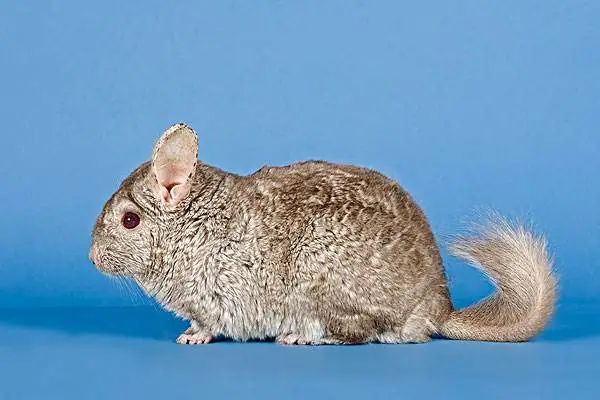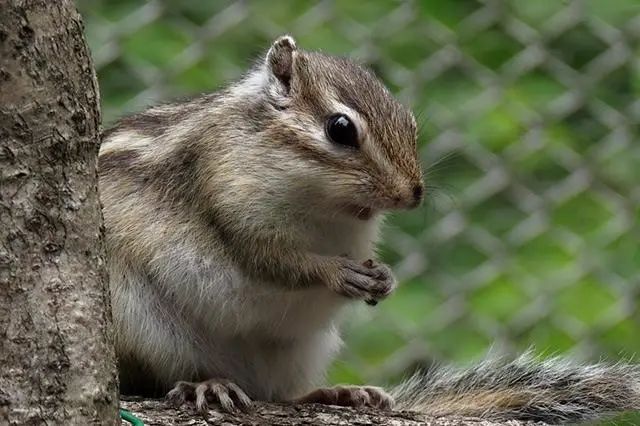The movie “My Neighbor Totoro” by Japanese animation master Hayao Miyazaki has introduced us to this kind of cute and honest animal. Many people may not be very familiar with Totoro. In fact, the real name of Chinchilla is South American chinchilla, but it was renamed by Hong Kong people as Chinchilla just because of the movie.

The standard grey chinchilla is native to the highlands of the Andes Mountains in South America. Chinchilla Chinese is called chinchilla or chinchilla, also called chinchilla. It is a historically existing rodent, translated directly from the Latin name Chinchilla. Average lifespan is 8-10 years, up to 20 years; lively and active, like to jump around, curious. Because chinchillas are clean and docile, easy to care for, and free of lice, they can be said to be ideal pets for urbanites.
Although they are both mice, there are many differences between chinchillas and hamsters. Hamsters are omnivores, chinchillas are vegetarians and have different digestive systems. Hamsters have double ovulation tubes, chinchillas have single ovulation tubes, so hamsters (including hamsters) can have a litter every 20 days, while chinchillas can only give birth 1-2 times a year, 1-2 each time.
The average lifespan of chinchillas is 8-10 years. Because of the food composition, chinchilla excrement is generally odorless. The chinchilla has tight hair, which is not conducive to the growth of parasites. They like to clean very much. If they accidentally messed up their hair, they would squat for half a day to fix it. It doesn’t require you to bathe it. It has special bath powder. Jumping in will roll over and cleanse your body. The chinchilla is docile and has a cute personality like a child. And the most amazing thing is that it has its own expression, you can even see it is incredible and thinking.

Standard grey chinchilla appearance features
Standard grey chinchillas and light black chinchillas are difficult to tell apart, and the price of chinchillas will vary depending on the color of the chinchilla. Only by clearly understanding the appearance characteristics of standard gray chinchillas can we not be deceived by merchants with ulterior motives.
Looking closely at the standard gray chinchilla, you can find that the abdomen of the standard gray chinchilla is white, and some front paws will turn black, but the hind paws will not have a foot line. There are also standard grey chinchillas whose palms are white. Viewed from the side, the abdomen of the standard grey chinchilla is black and white.
The above are the special appearance characteristics of the standard grey chinchilla. Others, such as chinchillas, have five fingers, four toes, and twenty teeth, including four incisors and sixteen large teeth. The average lifespan is 8-10 years, the longest is 20 years; lively and active, like to jump around, curiosity is no different from ordinary chinchillas.
Standard grey chinchilla feeding points
If you want to raise a standard grey chinchilla, you must pay attention to good feeding methods. For chinchillas, the temperature of the breeding environment is very important. Because chinchillas are sought after by many favorite pet friends, and the subsequent feeding problems are also valued by people, so how can you properly feed your standard gray chinchillas?
1. Before you decide to keep a standard grey chinchilla, you should prepare the following items to meet them.
1. Cage: Standard grey chinchillas should be placed in a cage to avoid biting furniture and wires in the room. Depending on the number, gender, and home space of your standard grey chinchillas, you can choose a cage that suits your standard grey chinchillas.
2. Toilet: The stool of the standard grey chinchilla has no peculiar smell, but the smell of urine is very strong. Therefore, it is recommended that the standard gray chinchilla develop the habit of urinating in the toilet, which will save a lot of effort.
3. Cushion material: Put the water-absorbing and odor-resistant cushion material into the standard gray chinchilla toilet or cage chassis, which can reduce the odor of standard gray chinchilla urine and prevent urine from corroding the plastic chassis and toilet.
4. Nest: The place where the standard grey chinchillas sleep, avoid dangerous harbors, and choose a suitable nest to make them feel comfortable and safe.
5. Teeth Molar Supplies: The incisors of the standard grey chinchilla continue to grow throughout their lives, so the standard grey chinchilla needs constant wear and tear to keep it healthy. Once the front teeth are too long, it can lead to difficulty eating and even death. It can be seen how important the standard gray chinchilla molars are.
6. Aquarius: A must-have for standard grey chinchillas to drink water. In order to maintain the sanitation and drinking water hygiene of the standard grey chinchilla room, we should give water to the standard grey chinchilla water bottle.
7. Food bowl: Develop good eating habits for standard grey chinchillas and eat with food bowls. Nowadays, there are many kinds of food bowls for standard grey chinchillas. It is best to choose a food bowl that is anti-bite and anti-turnover to prevent standard grey chinchillas from turning over their rice bowls.
8. Bathing utensils: Standard grey chinchillas are very convenient to take a bath, no need for people to bathe with water and dry with a hairdryer. Standard grey chinchillas bathe in sand and roll in the sand. So prepare special bath sand and bath containers for standard grey chinchillas.
9. Pedals: The standard grey chinchilla is an animal that likes to jump high, so put some pedals in the cage, let the standard grey chinchilla jump from below to a high place, choose different styles of pedals, and design each layer of pedals for the standard grey chinchilla. The location is also interesting.
Second, feeding standard gray chinchillas.
There are many considerations for feeding a standard grey chinchilla. If you feed too much or too little, pets can get sick. If you’re not careful, you can have more serious consequences. Therefore, the following points should be noted before feeding:
Just feed once every night. If the standard grey chinchilla is only three months old, the amount of food must be halved. Food volume increases with the age of the standard grey chinchilla until eight months of age. If there is too much or no leftover after feeding, pay attention to the feeding amount. If the standard grey chinchilla has a bad appetite, pay attention to your health. In addition, the amount of snacks should not be too much, and do not give stimulating food.
It only needs enough hay during the day to use as a grass school in its house.
Standard grey chinchilla breeding environment
For the standard gray chinchilla, it is difficult to spend the summer, because the standard gray chinchilla is an animal that is very prone to heat stroke, so be sure to pay attention to the environment layout and feeding methods in daily life.
First, the placement and drinking rules of standard grey chinchilla cages.
The cage must be placed in a high place, such as a table, cabinet, and chair, but it cannot be placed directly on the ground, because the standard gray chinchilla is hunted by eagles from the sky in the wild state. Cages should be placed in a cool place, not exposed to sunlight or draught.
The former will dehydrate the standard gray chinchilla, while the latter will cause the standard gray chinchilla to catch a cold.
Drinking water is usually cold boiled water, or human drinking water such as clean purified water and mineral water. Clean drinking water must be guaranteed at all times. Generally change the water in the kettle every other day and clean the kettle at the same time. Pay attention to cleaning the gasket of the bottle mouth to avoid the growth of microorganisms.
The kettle is best hung outside the cage. The suitable location we found was the door of a standard grey chinchilla cage. The height allows the standard grey chinchilla to stand in the cage and stand up to drink easily. And because the switch of the cage door is blocked, the standard gray chinchilla is not easy to damage the kettle body.
Second, not turning on the air conditioner is the standard method for gray chinchillas to escape the heat.
1. Buy two Pepsi-sized bottles with water in them that freeze into ice.
2. Buy two bags of pet ice (tech ice), which are very cheap and easy to buy. There are usually places that sell standard grey chinchillas, frozen.
3. Find a plastic tin box (be careful not to have edges and corners in the plastic, they will eat the plastic, and the box should not be painted)
4. Take a towel, then put the towel under the box, put two bags of about 300ML tech ice in it, put the cola ice on top of the tech ice, and finally put the towel on the box. Finally, place the box in your cage where they will lie down to escape the heat. It’s a bit cumbersome, but saves power.
Standard Grey Chinchilla Feeding Requirements
Although standard gray chinchillas and hamsters are different, when they are also mice, they should pay attention to the problem of grinding their teeth, otherwise the teeth will be too long and they will cause their diseases. Let me tell you five do’s and don’ts when feeding standard grey chinchillas and the importance of feeding standard grey chinchillas hay.
1. Feed standard grey chinchillas 5. Don’t.
1. Do not buy food with additives and preservatives from the supermarket, which will bring unpredictable danger to standard grey chinchillas.
2. Do not give standard grey chinchillas fresh vegetables and fruits. Foods with too much water can cause diarrhea in standard grey chinchillas, and only apples can eat a small amount of fresh.
3. Do not give standard grey chinchillas cooked seeds. The melon seeds are given to the standard grey chinchilla because the melon seeds contain the linoleic acid required by the standard grey chinchilla, which is good for the standard grey chinchilla’s hair. However, the linoleic acid in cooked melon seeds has been exhausted, and the cooked melon seeds that many people eat contain salt and additives. Salt can easily cause hair loss in standard grey chinchillas. Additives are not suitable for standard grey chinchillas. So to give the standard gray chinchillas sunflower seeds, more than 10 a day is enough.
4. Don’t give standard grey chinchillas soy. Eating a standard grey chinchilla’s stomach will absorb a lot of water, making the standard grey chinchilla feel bloated. Severe cases may lead to intestinal obstruction, life-threatening.
5. Don’t give standard grey chinchillas peanuts. Peanuts are too oily and not suitable for standard grey chinchillas.
Second, the importance of feeding hay to standard grey chinchillas.
Hay helps the standard grey chinchilla to grind its teeth, so if you don’t give the standard grey chinchilla hay, let the standard grey chinchilla commit suicide, be sure to give the standard grey chinchilla hay! Especially the grass pole, it is definitely a good thing for grinding teeth! Don’t say that just because you don’t like it, you should condone it. This is absolutely wrong! Grinding supplies, such as molar stones, apple branches, etc., can also be prepared for standard grey chinchillas. Of course, the standard gray chinchilla usually eats springboards and wooden nests and also plays the role of grinding teeth.